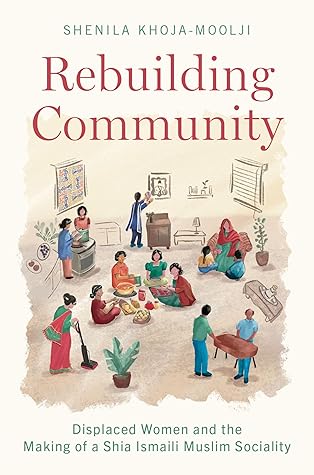Kindle Notes & Highlights
Read between
May 1, 2023 - December 27, 2024
“It is seva. It is khidmat. This is what it means to be a part of the Ismaili jamat. It is how we make it possible for other Ismailis to find a place here [in the United States].
“spiritualized socialities” or communities that are bound together through a shared orientation to the Divine.6 Relationalities like these can bridge and even transcend ethnic differences. Their salience is heightened in moments of dislocation as forced migration disrupts the bonds people enjoy to a fixed place, crucial to a sense of self and for accessing support.
Help where help is needed. Be generous where generosity is needed. Be strong where strength is needed. Be kind where kindness is needed.
viewing women’s reproductive activities as producing sociability, repairing past trauma, and furnishing continuity from one generation to the next.
They even developed an original script Khwajah Sindhi (or Khojki) that connected them to their Sindhi heritage.
It is in this social milieu, and over a period of some 150 years, that the identity of satpanthi Khojas transformed from a group that could be simultaneously understood as a caste, a trader’s guild, and a panth to a distinctly Muslim jamat: Shia Ismaili Muslims.
British policies thus created a virtual Asian monopoly over business enterprise and produced social divisions, which local populations resented.50 This resentment coalesced with movements for independence after the Second World War to create widespread anti-Asian sentiment and racial conflict.
These care tasks include activities for the biological reproduction of the community as well as those that facilitate its religio-cultural reproduction—such as telling stories about the Imam’s miracles or writing cookbooks to transmit Ismaili food cultures. As
Ma Vang reframes Hmong refugee women as carriers of communal histories and place-based knowledges.71
My interlocutors do not perceive cleaning jamatkhanas and cooking for coreligionists through a lens of gendered exploitation but rather regard these activities as blessings, privileges, and opportunities offered by the Imam.
Yasmin Alibhai-Brown calls Ismailis a “people in motion . . . who settle but cautiously . . . a people who leave no trace . . . [a people with a] nomadic history . . . [a] roaming tribe.”74
The present Ismaili Imam has insisted that ethics bridge faith and world (din and dunya), and this study accordingly looks at ethics in practice.94
In the Shia worldview, the Imam is understood to be a manifestation (mazhar) of God on earth and has God-given sanctity (walaya).96 He has knowledge of both the exoteric/apparent (zahir) and the esoteric/hidden (batin) dimensions of reality. The Imam complements the Prophet’s mission (nabuwwat) by teaching initiates the hidden spiritual meaning
(tawil) of the Revelation.
enmeshments
hermeneutic
[A] remembrance is in very large measure a reconstruction of the past achieved with data borrowed from the present, a reconstruction prepared, furthermore, by reconstructions of earlier periods wherein past images had already been altered.”
Imam had instructed his followers not to allow differences in dialect or culture to divide them further, and called on them to work in unison like a panj (a palm or fist), whose fingers are weak individually but strong together.2
Ma taught me the meaning of the word Santosh. She used to say if you have santosh, you have everything. Without santosh you have nothing. Those words still ring true for me today.
The Sanskrit term santosh or saṃtoṣa denotes contentment.
If a man has two children—one boy and the other a girl, and if he can only afford to give education to one, I would say that he must give preference to the girl.
Yi-Fu Tuan refers to such bonds between people and places as “fields of care.”8 This
“When I am happy with somebody, I give seva. And when I am happier, I give them more seva.”
Nani passed away as I was drafting this chapter in the spring of 2021.
As a child, I did not understand why nani spoke Gujarati and not Sindhi, my “mother tongue”—or, in this case, my father’s tongue. I did not recognize all the ways that her life was marked by displacement and dispossession, or how her body and her care practices carried remnants of other places.
Food, of course, is not only about nourishment. It tells a tale about where, how, and when it was created and about the people who consumed it. It is tied to political economy and social class. Its modifications and fusions reveal encounters between people and places in the diaspora. Its preparation is both an expression of care and subject to exploitation.
At the same time, all three enjoyed the opportunity to reinvent themselves due to their social class, education, and location in North America / Britain; for many other Ismaili women, like nani, who remained working class throughout their lives, the opportunity for independent enterprise continued to be limited. For them, transmission of culinary knowledge remains an oral tradition.


